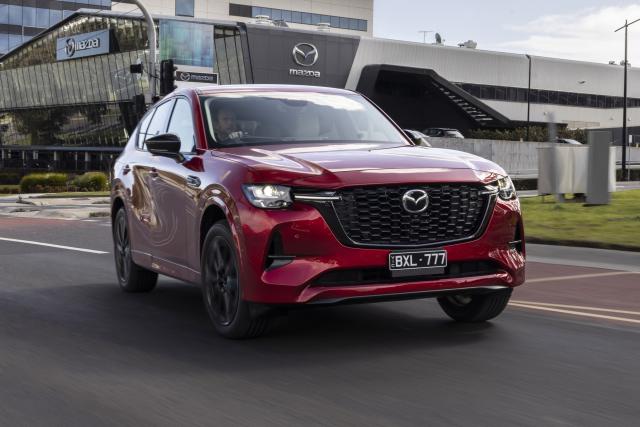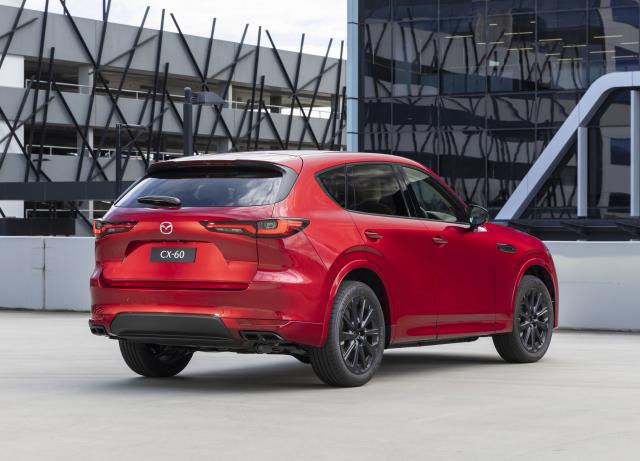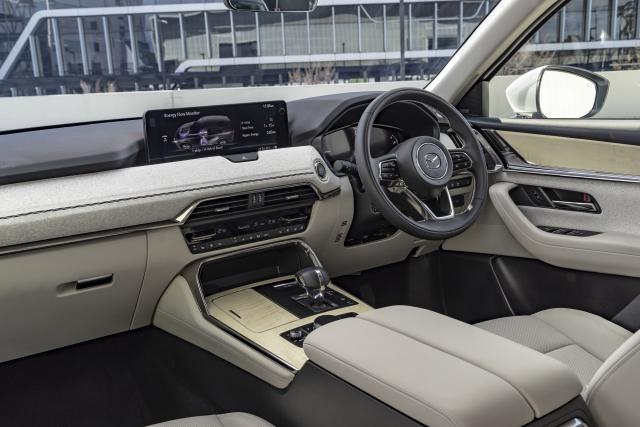The Mazda lineup is becoming increasingly difficult to understand.
Once upon a time there was the Mazda2, Mazda3, and Mazda6 and it was easy to follow the progression (not forgetting the MX-5 and RX-8 sports cars). Then along came the SUVs, denoted by a CX in front of the number – CX-3, CX-5, CX-8 and CX-9.
All good so far, except perhaps for CX-3 which actually sits on the same platform as Mazda2, making it smaller than its name might suggest.
More recently the CX-30 and MX-30 were added, including a fully electric version of the MX – Mazda’s first EV. We’re not sure how or where the MX fits in, but to be frank it’s a bit of a non-event anyway with its silly doors.
Now they’ve begun adding extra digits to the CX range, in the form of the CX-30, CX-60 and CX-90. It’s all a bit confusing and the thing is if we’re confused, how must the buying public feel, and isn’t that bad for sales?
Which brings us to the subject of our test drive, the all-new, five-seat CX-60, a car that’s reportedly designed to take Mazda into hitherto uncharted premium territory.
Sitting on new rear-wheel drive architecture with straight six rather than V6 engines, there’s no prizes for guessing which brand Mazda has in its crosshairs – make that BMW.
STYLING
The launch of the Mazda6 in 2002 was something of a turning point for the Japanese brand.
Since then, it has demonstrated an uncanny ability to produce cars that are more than the sum of their parts, vehicles that look and feel more expensive than they actually cost to build.
This design philosophy, known as Stylish, Insightful and Spirited, has seen Mazda climb to the number two position in the Australian market, second only to the seemingly unassailable Toyota.
But, like other Japanese and Korean car makers, Mazda must be starting to feel pressure from the Chinese, whose cars are rapidly getting better and have begun pinching sales from established brands.
They can’t match the Chinese on price, so the only place left to go is up, producing more expensive models that carry a greater profit margin because they are unlikely to sell as many.
The CX-60 is the first of these models.
Mazda reckons CX-60 takes the premium experience to a new level.
It’s a high-quality concentration of design, driving dynamics, technology and comfort – developed around what customers want from a mid-sized SUV.
That’s the spin anyway. Whether people want or are prepared to pay more for their cars is another matter.
CX-60 is priced from $59,800 plus on-road costs.
There’s three grades and three different powertrains from which to choose, all of them hybrids – Evolve, GT and Azami.
And, at a time when most manufacturers are downsizing engines, always the innovator, Mazda has opted to go big with two six-cylinder offerings.
Kicking off proceedings is the 3.3-litre turbocharged six-cylinder petrol Evolve from $59,800, followed by the 3.3-litre turbocharged six-cylinder diesel from $61,800 and finally a 2.5-litre four cylinder turbocharged plug-in hybrid that starts from $72,300.
Whatever grade you choose, you can pick any one of these powertrains.
Our test vehicle is the CX-60 Azami with the 3.3-litre petrol hybrid and optional Takumi package, priced from $75,000 plus-on road costs.
Standard equipment includes artificial leather and dual-zone climate control with rear vents, while the steering wheel and transmission lever are trimmed in real leather.
Wheels range from 18 to 20-inch in size, with black body cladding and heated body-coloured exterior mirrors that dim and fold automatically, along with a power-operated tailgate.
There’s also head-up display, 7.0-inch driver display, LED lights, auto high beam, keyless entry and start, auto dimming mirror, auto lights and wipers, and front and rear parking sensors.
GT and Azami add 20-inch alloys, panoramic sunroof, full leather trim, heated steering wheel, electric steering wheel adjustment, heated power-adjust front seats, 12.3-inch infotainment and a fully digitised 12.3-inch instrument cluster and 12-speaker Bose audio.
They also boast the new driver personalisation system which automatically adjusts the driver position to each driver.
The system uses facial recognition to remember each driver’s preferences.
Azami ups the ante with Nappa leather, ventilated front seats, LED ambient lighting, leather side door trim with courtesy light, 360-degree see-through monitor and adaptive headlights.
It also adds easy entry and driving position guide to the personalise system.
Our test vehicle was also fitted with the $2000 Takumi package which includes white Nappa leather, white maple wood console panel and cloth dashboard panel with ‘Kakenui’ stitching.
CX-60 is covered by a five-year unlimited kilometre warranty with five-year roadside assistance, with service intervals of 15 months/15,000km.
INFOTAINMENT
Infotainment consists of a 10.25-inch display which grows to 12.3 inches in higher grades, but as is the norm with Mazda neither are touchscreens and must be controlled from the centre console.
Eight-speaker audio is standard with Bluetooth, built-in navigation, AM/FM/DAB+ digital radio, Apple Carplay and Android Auto (wireless and USB), plus wireless phone charging.
There’s two USB-C ports front and back, plus a 12V/120W socket in the front, 150W AC socket in the back, plus another 12V/120W socket in the luggage area.
The plug-in hybrid scores a rear 1500W AC three-pin power outlet.
ENGINES/TRANSMISSIONS
The 48-volt mild hybrid powertrain delivers 209kW of power from 5000-6000 rpm and 450Nm of torque from 2000-3500 rpm, propelling the wagon to 100km/h in 6.9 seconds.
In comparison, the diesel delivers 187kW and 550Nm while the plug-in hybrid puts out 241kW and 500Nm.
With auto-stop-start and an eight-speed auto, drive is to all four wheels via a torque on demand system.
It is predominantly rear-wheel drive.
SAFETY
Five-star safety includes front, side and curtain airbags, as well as a driver knee airbag and centre airbag designed to stop front seat occupants bumping heads in a side impact.
There’s a 360-degree camera, Smart Brake Support (SBS) with Turn-across traffic and Blind Spot Monitoring (BSM) with Vehicle Exit Warning.
Autonomous emergency braking (Car-to-Car, Vulnerable Road User and Junction Assist) as well as a lane support system with lane keep assist (LKA), lane departure warning (LDW) and emergency lane keeping (ELK), and blind spot monitoring (BSM) are also standard.
DRIVING
CX-60 feels big and hefty. It’s 16.5cm longer than CX-5, but 16cm shorter than CX-8.
And it weighs 1949kg, about 220kg more than the top CX-5 – but 28kg less than the range-topping diesel CX-8.
Mazda argues the large capacity 3.3-litre engines actually improve efficiency.
It says the higher volume of air enables more complete combustion and a wider lean-burn range, leading to lower fuel use and reduced engine emissions.
With a 58-litre tank, fuel consumption is a claimed 7.4L/100km, compared with the 2.5-litre turbo CX-5 which is good for 8.2 (and it takes standard unleaded).
Mazda says the use of a clutch in place of a torque converter means switching between gears is clean and rhythmic.
It also enables accurate control of the electric motor. But it’s not the smoothest.
Drive modes include Normal, Sport, Off-Road and Towing.
Performance is strong, six-cylinder strong, with a feel and note to match, as the wagon gathers speed, remembering it’s a straight six.
Just driving around, however, it feels like an excited dog on a leash.
The transmission, which also manages assistance from the electric motor, seems unable to settle down, constantly straining forward and falling back again.
Prodding the accelerator in any gear produces an initial, half-second hiccup before the wagon responds.
Cleverly, when you back off and the engine is no longer under load, the tacho needle flat lines as the six shuts down for several seconds at a time.
Oddly, of the various drive modes, Off-Road mode felt the more relaxed, even without leaving the bitumen – and that’s where we left it.
But it’s not all peaches and cream, because twice in the course of the week the CX-60 refused to start.
Put the transmission in Park, the message warned us. Trouble is, we were already in Park and no amount of prodding the start button could spur the thing into life.
Park resides up and to the right by way of explanation. Further investigation revealed it was possible to put it in Park, but not fully in Park, even though the light confirmed it was.
The transmission needs to be pushed firmly forward and all the way to the right before it will start.
It’s all good, once you know the trick, but we found the change generally awkward to use when moving rapidly between forward and reverse.
The suspension is biased towards the softer end of the spectrum, with a cabin that is well insulated but feels somewhat isolated, detracting from the overall drive experience.
CX-60 sits reasonably flat and corners enthusiastically, but jars on city roads and became bouncy at speed on a country run.
After going through the routine to set up driver personalisation, it failed to activate when we returned to the car.
Guess you need three profiles, one with glasses, one with sunglasses and one without – or remember to take them off.
Walkaway locking is signified by the mirrors folding. Sometimes it works, sometimes it doesn’t (a bit of a worry).
The long thin infotainment screen is ideal for Android Auto which splits the screen in a 2:1 ratio, with the larger section just right for navigation and the smaller area perfect for music.
Having said that, the screen went blank at one point and returned only after we switched the car off and on.
Unlike most hybrids, fuel consumption drops fairly quickly on the motorway. We were getting 9.2L/100km after close to 400km of mixed driving including some dirt roads, but this dropped to 8.7L/100km on the run into Sydney.
SUMMING UP
If it was our money, we’d take the top-of-the-line CX-8 turbo-diesel Asaki LE.
It is a little larger, but doesn’t feel so and costs slightly less at $72,010 plus on-roads.
With quilted leather and real wood inlays, the CX-8 simply oozes class, with sharper ride and handling belying its size.
It also gets better fuel consumption.
Grab one while you can.









